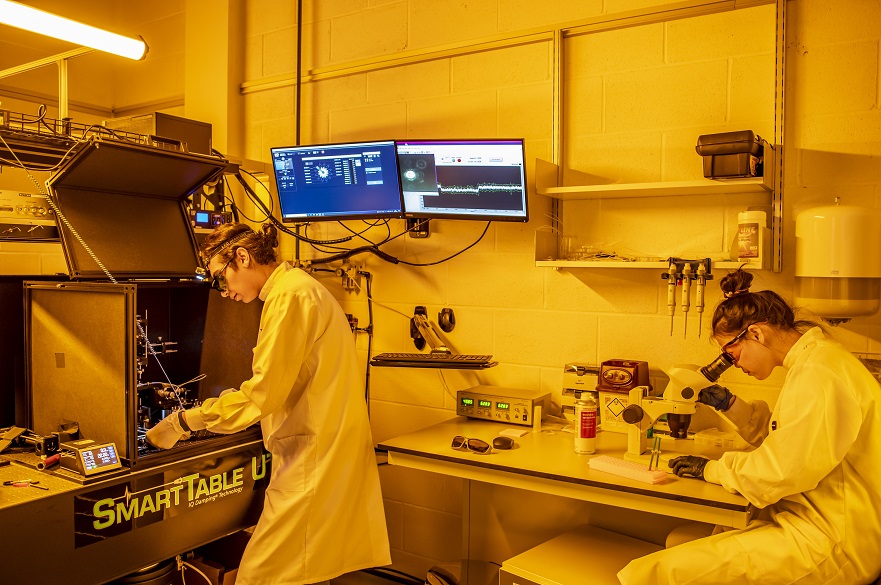First of its kind study of single protein paves way to improving understanding of disease
Scientists have developed new technology which has made it possible to isolate and study how a single protein – 10,000 times thinner than a human hair – behaves and changes over time.

The Nottingham Trent University team says the work – the first of its kind – enables them to see how a protein behaves in its natural environment and that it could help better understand proteins linked to disease and how they might respond to certain therapies.
The research involves using a very high concentration of light which, when the beam is transmitted through a specifically engineered nano structure, generates the right amount of force to grasp and hold a single protein within the fluid without damaging it.
The technology is able to detect how the light is scattered and the researchers can analyse this unique data to reveal how the protein is behaving in real-time.
The protein is studied in its natural liquid environment, as the team’s technique can mimic the body by altering factors such as salt concentration, pH, or oxygen levels.
As a proof of concept the researchers studied ferritin, a protein in the blood which stores and releases iron to prevent diseases associated with iron dysregulation, such as anaemia.
During the study they were able to distinguish between the ferritin with iron and without – as the data revealed differences in their weight and movement – and even the point at which the ferritin without iron began capturing and storing iron.
They say that the study has deepened understanding of the iron uptake mechanism of ferritin proteins, which could lead to new therapeutics for iron-related diseases.
Until now, studies of ferritin have only been able to use ensemble measurements to quantify the characteristics of a large number of proteins, which provides limited information about their structural changes.
The researchers argue that because protein changes occur before symptoms in illness, their work could make it possible to identify and treat a range of diseases much earlier.
“To be able to see things beyond your eyesight, you first need the right technology. Our nanostructure enables us to observe proteins at the nano-scale,” said lead researcher Dr Cuifeng Ying from Nottingham Trent University’s School of Science and Technology.
She said: “This technique allows us to study the behaviour of a single living protein by using a high intensity light beam to trap, hold and study it in its own environment. Normally you’d need to study many proteins together to see how the group responds.
“Lots of proteins are linked to disease; if we can see the root problem then we can potentially treat them better and earlier.”
Arman Yousefi, a PhD candidate at Nottingham Trent University, and the first author of this study, said: “The scattered light provides us with a unique fingerprint to show us how the protein is behaving. With regards to ferritin, we observed the rigid and relaxed state of the protein with and without iron and even the process of collecting and storing the iron from its environment.”
Mohsen Rahmani, Professor of Engineering at NTU and a Royal Society Wolfson Fellow, added: “This technology and technique give us the potential to identify protein changes in relation to disease emergence and progression. We can look at lots of proteins and see how they react to different drugs. In the future this breakthrough could play a key role in improving survival rates and reducing healthcare costs.
“There has previously been no tool to enable us to study proteins in this way without destroying them.
The study, which also involved the University of Nottingham and the Adolphe Merkle Institute at the University of Fribourg in Switzerland, is published in the journal Nano Letters.
-
Notes for editors
Press enquiries please contact Dave Rogers, Public Relations Manager, on telephone +44 (0)115 848 8782, or via email.
Nottingham Trent University (NTU) received the Queens Anniversary Prize for Higher and Further Education in 2021 for cultural heritage science research. It is the second time that NTU has been bestowed the honour of receiving a Queen’s Anniversary Prize for its research, the first being in 2015 for leading-edge research on the safety and security of global citizens.
The Research Excellence Framework (2021) classed 83% of NTU’s research activity as either world-leading or internationally excellent. 86% of NTU’s research impact was assessed to be either world-leading or internationally excellent.
NTU was ranked second best university in the UK in the Uni Compare Top 100 rankings (2021/2022). It was awarded Outstanding Support for Students 2020 (Times Higher Education Awards), University of the Year 2019 (Guardian University Awards, UK Social Mobility Awards), Modern University of the Year 2018 (Times and Sunday Times Good University Guide) and University of the Year 2017 (Times Higher Education Awards).
NTU is the 5th largest UK institution by student numbers, with nearly 39,000 students and more than 4,400 staff located across five campuses. It has an international student population of 7,000 and an NTU community representing over 160 countries.
Since 2000, NTU has invested £570 million in tools, technology, buildings and facilities.
NTU is in the UK’s top 10 for number of applications and ranked first for accepted offers (2021 UCAS UG acceptance data) It is also among the UK’s top five recruiters of students from disadvantaged backgrounds and was the first UK university to sign the Social Mobility Pledge.
75% of NTU students go on to graduate-level employment or graduate-entry education / training within fifteen months of graduating (Guardian University Guide 2021).
NTU is ranked 2nd most sustainable university in the world in the 2022 UI Green Metric University World Rankings (out of more than 900 participating universities).
- Subject area: Computing, engineering, maths and other technologies
- Category: Press office; Research; School of Science and Technology


